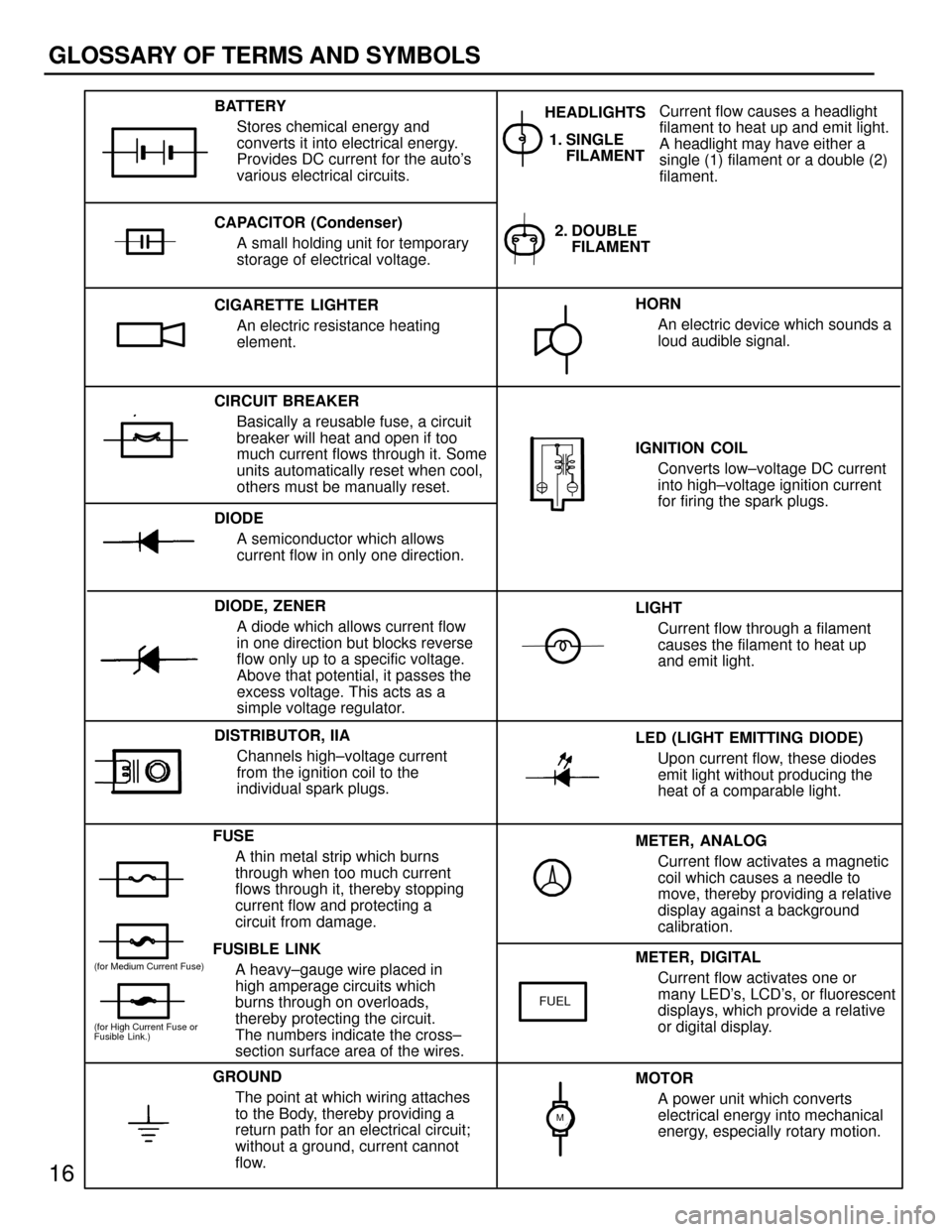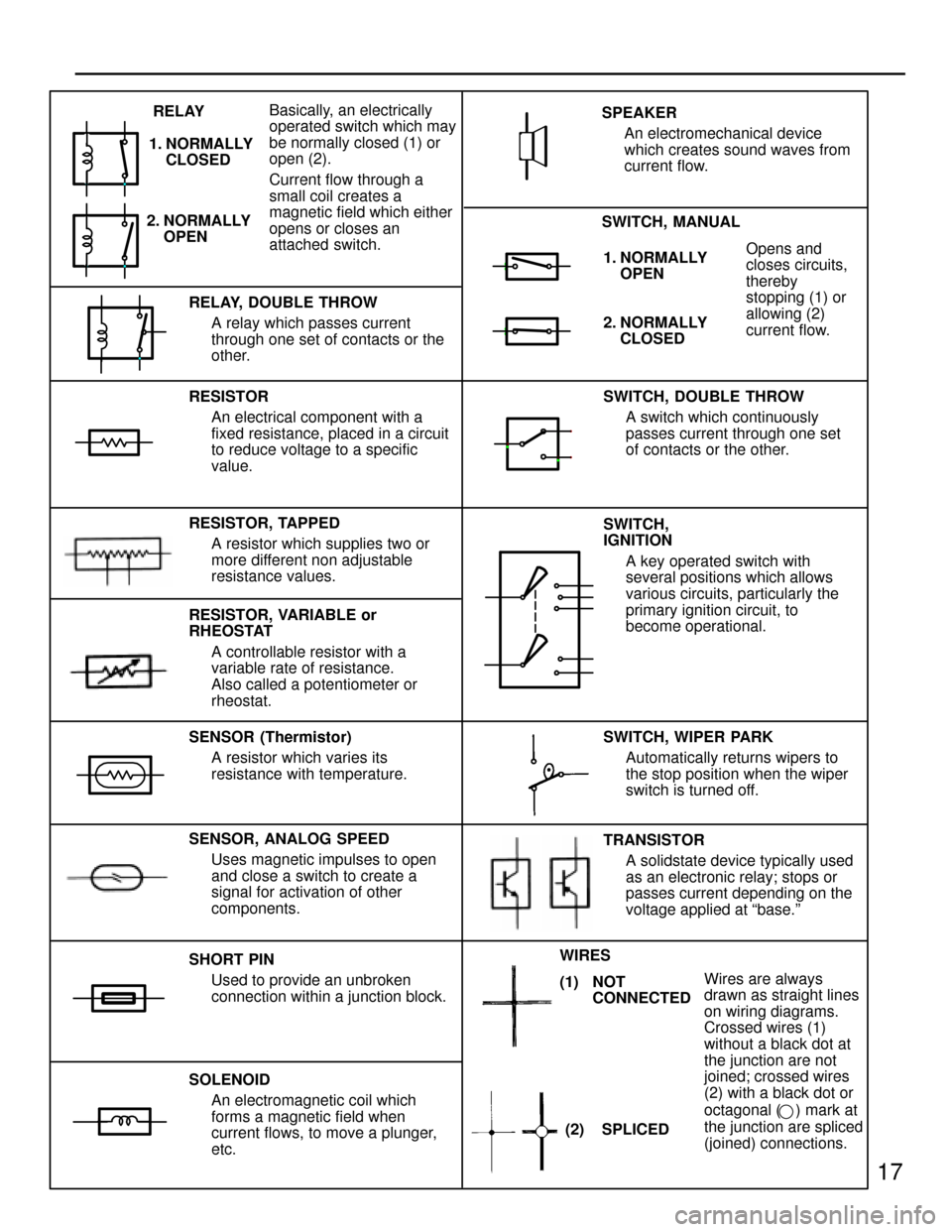TOYOTA CAMRY 1994 XV10 / 4.G Wiring Diagrams User Guide
Manufacturer: TOYOTA, Model Year: 1994, Model line: CAMRY, Model: TOYOTA CAMRY 1994 XV10 / 4.GPages: 307, PDF Size: 5.48 MB
Page 11 of 307

11
FINDING A SHORT CIRCUIT
(a) Remove the blown fuse and disconnect all loads of the
fuse.
(b) Connect a test light in place of the fuse.
(c) Establish conditions in which the test light comes on.
Example:
± Ignition SW on
± Ignition SW and SW 1 on
± Ignition SW, SW 1 and Relay on (Connect the
Relay) and SW 2 off (or Disconnect SW 2)
(d) Disconnect and reconnect the connectors while
watching the test light.
The short lies between the connector where the test
light stays lit and the connector where the light goes
out.
(e) Find the exact location of the short by lightly shaking
the problem wire along the body.
CAUTION
(a) Do not open the cover or the case of the ECU unless
absolutely necessary. (If the IC terminals are touched,
the IC may be destroyed by static electricity.)
(b) When replacing the internet mechanism (ECU part) of
the digital meter, be careful that no part of your body or
clothing comes in contact with the terminals of leads
from the IC, etc. of the replacement part (spare part).
DISCONNECTION OF MALE AND FEMALE
CONNECTORS
To pull apart the connectors, pull on the connector itself, not the
wire harness.
HINT: Check to see what kind of connector you are disconnecting
before pulling apart.
Page 12 of 307

12
TROUBLESHOOTING
HOW TO REPLACE TERMINAL
(with terminal retainer or secondary locking
device)
1. PREPARE THE SPECIAL TOOL
HINT: To remove the terminal from the connector, please
construct and use the special tool or like object shown
on the left.
2. DISCONNECT CONNECTOR
3. DISENGAGE THE SECONDARY LOCKING DEVICE OR
TERMINAL RETAINER.
(a) Locking device must be disengaged before the
terminal locking clip can be released and the terminal
removed from the connector.
(b) Use a special tool or the terminal pick to unlock the
secondary locking device or terminal retainer.
NOTICE:
Do not remove the terminal retainer from connector body.
For Non±Waterproof Type Connector
HINT: The needle insertion position varies according
to the connector's shape (number of terminals
etc.), so check the position before inserting it.
ªCase 1º
Raise the terminal retainer up to the temporary
lock position.
ªCase 2º
Open the secondary locking device.
Page 13 of 307

13
For Waterproof Type Connector
HINT: Terminal retainer color is different
according to connector body.
Example:
Terminal Retainer
: Connector Body
Black or White : Gray
Black or White : Dark Gray
Gray or White : Black
ªCase 1º
Type where terminal retainer is pulled up
to the temporary lock position (Pull Type).
Insert the special tool into the terminal
retainer access hole ( Mark) and pull the
terminal retainer up to the temporary lock
position.
HINT: The needle insertion position varies
according to the connector's shape
(Number of terminals, etc.), so check the
position before inserting it.
ªCase 2º
Type which cannot be pulled as far as
Power Lock insert the tool straight into the
access hole of terminal retainer as shown.
Page 14 of 307

14
TROUBLESHOOTING
Push the terminal retainer down to the temporary lock
position.
(c) Release the locking lug from terminal and pull the
terminal out from rear.
4. INSTALL TERMINAL TO CONNECTOR
(a) Insert the terminal.
HINT:
1. Make sure the terminal is positioned correctly.
2. Insert the terminal until the locking lug locks firmly.
3. Insert the terminal with terminal retainer in the
temporary lock position.
(b) Push the secondary locking device or terminal retainer
in to the full lock position.
5. CONNECT CONNECTOR
Page 15 of 307

15
ABBREVIATIONS
ABBREVIATIONS
The following abbreviations are used in this manual.
ABS = Anti±Lock Brake System
ACIS = Acoustic Control Induction System
A/C = Air Conditioning
A/T = Automatic Transmission
COMB. = Combination
C/P = Coupe
ECU = Electronic Control Unit
EFI = Electronic Fuel Injection
EGR = Exhaust Gas Recirculation
ESA = Electronic Spark Advance
Ex. = Except
FL = Fusible Link
IAC = Idle Air Control
ISC = Idle Speed Control
J/B = Junction Block
LH = Left-Hand
MFI = Multiport Fuel Injection
M/T = Manual Transmission
O/D = Overdrive
R/B = Relay Block
RH = Right±Hand
RPM = Engine Speed
S/D = Sedan
SFI = Sequential Multiport Fuel Injection
SRS = Supplemental Restraint System
SW = Switch
TEMP. = Temperature
VSV = Vacuum Switching Valve
W/G = Wagon
w/ = With
w/o = Without
*The titles given inside the components are the names of the terminals (terminal codes) and
are not treated as being abbreviations.
Page 16 of 307

METER, ANALOG
Current flow activates a magnetic
coil which causes a needle to
move, thereby providing a relative
display against a background
calibration. LED (LIGHT EMITTING DIODE)
Upon current flow, these diodes
emit light without producing the
heat of a comparable light. IGNITION COIL
Converts low±voltage DC current
into high±voltage ignition current
for firing the spark plugs. 1. SINGLE
FILAMENT
GROUND
The point at which wiring attaches
to the Body, thereby providing a
return path for an electrical circuit;
without a ground, current cannot
flow.Current flow causes a headlight
filament to heat up and emit light.
A headlight may have either a
single (1) filament or a double (2)
filament. BATTERY
Stores chemical energy and
converts it into electrical energy.
Provides DC current for the auto's
various electrical circuits.
CAPACITOR (Condenser)
A small holding unit for temporary
storage of electrical voltage.
CIRCUIT BREAKER
Basically a reusable fuse, a circuit
breaker will heat and open if too
much current flows through it. Some
units automatically reset when cool,
others must be manually reset.
DIODE
A semiconductor which allows
current flow in only one direction.
DIODE, ZENER
A diode which allows current flow
in one direction but blocks reverse
flow only up to a specific voltage.
Above that potential, it passes the
excess voltage. This acts as a
simple voltage regulator.
FUSE
A thin metal strip which burns
through when too much current
flows through it, thereby stopping
current flow and protecting a
circuit from damage.
FUSIBLE LINK
A heavy±gauge wire placed in
high amperage circuits which
burns through on overloads,
thereby protecting the circuit.
The numbers indicate the cross±
section surface area of the wires.HORN
An electric device which sounds a
loud audible signal.
LIGHT
Current flow through a filament
causes the filament to heat up
and emit light.
METER, DIGITAL
Current flow activates one or
many LED's, LCD's, or fluorescent
displays, which provide a relative
or digital display.
MOTOR
A power unit which converts
electrical energy into mechanical
energy, especially rotary motion. CIGARETTE LIGHTER
An electric resistance heating
element.
DISTRIBUTOR, IIA
Channels high±voltage current
from the ignition coil to the
individual spark plugs.2. DOUBLE
FILAMENT HEADLIGHTS
FUEL
(for High Current Fuse or
Fusible Link.)
(for Medium Current Fuse)
M
16
GLOSSARY OF TERMS AND SYMBOLS
Page 17 of 307

17
1. NORMALLY
OPENOpens and
closes circuits,
thereby
stopping (1) or
allowing (2)
current flow.
RESISTOR
An electrical component with a
fixed resistance, placed in a circuit
to reduce voltage to a specific
value.
RESISTOR, TAPPED
A resistor which supplies two or
more different non adjustable
resistance values.
SENSOR (Thermistor)
A resistor which varies its
resistance with temperature.
SHORT PIN
Used to provide an unbroken
connection within a junction block.
SOLENOID
An electromagnetic coil which
forms a magnetic field when
current flows, to move a plunger,
etc.SWITCH, DOUBLE THROW
A switch which continuously
passes current through one set
of contacts or the other.
SWITCH,
IGNITION
A key operated switch with
several positions which allows
various circuits, particularly the
primary ignition circuit, to
become operational.
Wires are always
drawn as straight lines
on wiring diagrams.
Crossed wires (1)
without a black dot at
the junction are not
joined; crossed wires
(2) with a black dot or
octagonal (
) mark at
the junction are spliced
(joined) connections. RELAY, DOUBLE THROW
A relay which passes current
through one set of contacts or the
other.
SENSOR, ANALOG SPEED
Uses magnetic impulses to open
and close a switch to create a
signal for activation of other
components.TRANSISTOR
A solidstate device typically used
as an electronic relay; stops or
passes current depending on the
voltage applied at ªbase.º SWITCH, WIPER PARK
Automatically returns wipers to
the stop position when the wiper
switch is turned off. SWITCH, MANUAL SPEAKER
An electromechanical device
which creates sound waves from
current flow.
2. NORMALLY
CLOSED
RESISTOR, VARIABLE or
RHEOSTAT
A controllable resistor with a
variable rate of resistance.
Also called a potentiometer or
rheostat. 2. NORMALLY
OPEN RELAY
1. NORMALLY
CLOSEDBasically, an electrically
operated switch which may
be normally closed (1) or
open (2).
Current flow through a
small coil creates a
magnetic field which either
opens or closes an
attached switch.
(2) SPLICED WIRES
(1) NOT
CONNECTED
Page 18 of 307
![TOYOTA CAMRY 1994 XV10 / 4.G Wiring Diagrams User Guide [Instrument Panel]
18
RELAY LOCATIONS
[Engine Compartment] TOYOTA CAMRY 1994 XV10 / 4.G Wiring Diagrams User Guide [Instrument Panel]
18
RELAY LOCATIONS
[Engine Compartment]](/img/14/6859/w960_6859-17.png)
[Instrument Panel]
18
RELAY LOCATIONS
[Engine Compartment]
Page 19 of 307
![TOYOTA CAMRY 1994 XV10 / 4.G Wiring Diagrams User Guide [Sedan]
[Coupe]
[Wagon]
19
[Body] TOYOTA CAMRY 1994 XV10 / 4.G Wiring Diagrams User Guide [Sedan]
[Coupe]
[Wagon]
19
[Body]](/img/14/6859/w960_6859-18.png)
[Sedan]
[Coupe]
[Wagon]
19
[Body]
Page 20 of 307

20
RELAY LOCATIONS
������ ���: J/B No. 1Instrument Panel Left(See Page 18)